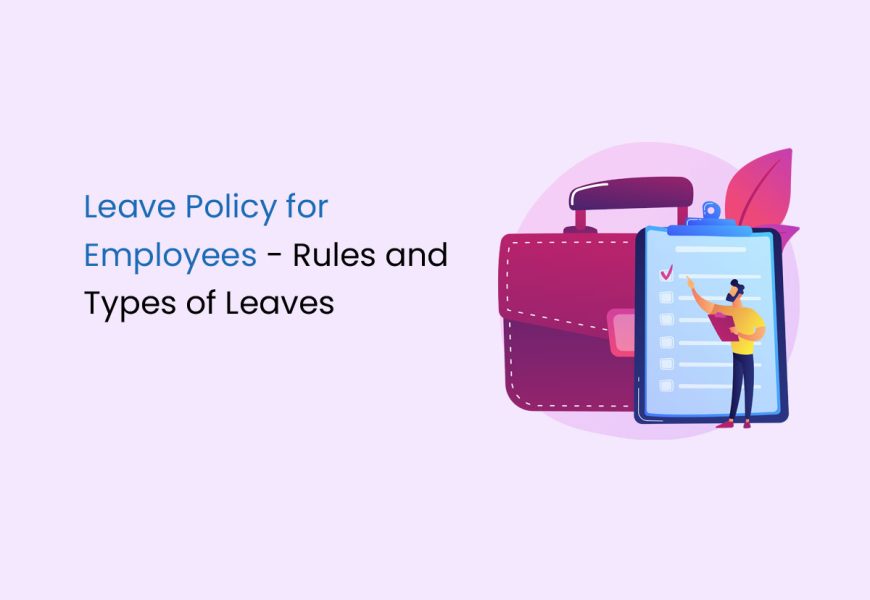Employees in the public and private sectors are entitled to a certain number of leaves per year, in addition to holidays and days off. These leaves help them maintain a healthy work-life balance. The type and number of leaves employees are entitled to depend on their employer and industry. In India, every state has its leave policy and entitlement.
This blog will explore leave policies, types of leaves, the rules, the need for a leave policy and more.
What is a Leave Policy?
A leave policy outlines the rules for different types of leaves an employee can take. It specifies the types of leaves for different situations, such as vacation, sickness, maternity, grief, etc. The policy also lists the rules for leave granting, eligibility, availing, encashment, etc. Indian labour laws give employees who work at least 240 days a year 12 working days of paid or annual leave.
Need for Leave Policy
Employees have the right to take leave, and employers must grant it as per the Factories Act and state-level Shops and Commercial Establishment Acts in India. Leaves are crucial for personal and emergency reasons. Paid vacation time is necessary for employees to recharge, leading to greater productivity and job satisfaction. Research indicates that a leave policy prioritising employee needs can improve satisfaction, loyalty, and productivity. A well-defined and consistent leave policy fosters trust and satisfaction in employees and builds a strong employer brand.
Importance of Leave Policy
The importance of a well-structured leave policy cannot be overstated in any organisation. The significance of a leave policy is as follows:
- Employee Satisfaction and Mental Well-being: A clear and fair leave policy demonstrates an organisation’s commitment to employee welfare, which leads to higher employee satisfaction. It allows employees to take time off for personal reasons without jeopardising their job security or facing unnecessary conflicts.
- Organised Work Culture: A leave policy establishes clear guidelines for managing leave entitlements, reducing ambiguity and conflict. Outlining rules for leave applications, approvals, and entitlements promotes transparency, accountability, and fairness.
- Limiting Leaves and Enhancing Productivity: Limiting employee leaves prevents abuse of leave privileges and ensures responsible leave management. It helps maintain productivity levels and minimises disruptions to workflow. Explicit leave policy constraints encourage effective planning, leading to better resource allocation and project management.
- Eliminating Grey Areas and Ensuring Compliance: A clear leave policy eliminates confusion about entitlements and procedures. It defines leave types, the application process, and any specific requirements. This helps employees make informed decisions, and HR managers administer leave benefits consistently and legally.
- Streamlining Expenses and Payroll Management: A leave policy helps HR departments track leave balances, monitor trends, and ensure correct compensation. This facilitates payroll processing, reduces errors, and enhances efficiency.
- Promoting Work-Life Balance: A leave policy supports work-life balance, acknowledges personal time, and empowers employees to prioritise their well-being. This improves morale, retention rates, and job satisfaction.
- Conflict Resolution and Employee Relations: A well-defined leave policy with clear guidelines and procedures can prevent misunderstandings and conflicts regarding leave entitlements and make employees feel secure and confident. Additionally, optional holiday provisions in the policy show respect for diverse cultural and religious beliefs, promoting inclusivity and strengthening employee relations.
- Assisting in Planning and Resource Management: Leave policies help managers plan staff schedules and maintain operational continuity during employee absences. This proactive approach enhances organisational agility and resilience, ensuring productivity and quality of service are not compromised.
Types of Leave
National and state laws mandate minimum leave, but specifics vary between employers offering additional leave types. The types of leave offered are as follows:
Earned Leave
Earned Leave (EL) is a type of leave earned for days worked and can also be known as Vacation Leave, Privilege Leave, Flexi Holiday, or Annual Leave. It’s usually used for personal reasons such as vacations or festivals. Extended leave needs to be planned ahead of time and is considered for a week or more. The leave balance at the end of the year is carried forward to the following year. It can also be converted to cash through a process called Leave Encashment.
Casual Leave
Companies offer different types of leave to their employees. One is Casual Leave for unforeseen personal situations. Unlike planned Earned Leave, it can be taken at short notice. It is mandatory in some states but not in others. In some states, there is a combined entitlement for Casual Leave and Sick Leave. If it is not compulsory for your business, you can use Earned Leave instead.
Sick Leave
Sick Leave (SL) or Medical Leaves (ML) are given in case of sickness or accidents. Employers usually ask for a medical certificate if the sick leave exceeds 2-3 days. In some states, there is a combined entitlement for Casual Leave (CL) and Sick Leave (SL). In some states, payment for CL/SL is only 50% of the salary instead of full pay.
Maternity Leave
The Maternity Benefit Act of 1961 requires employers to give 26 weeks of paid maternity leave to women who have worked for at least 80 days in the 12 months before the expected delivery date. This leave is applicable for the first two children only, with 12 weeks available for a third child. The Act also provides for mandated leave in case of miscarriage, adoption, surrogacy, and tubectomy.
Marriage Leave
Marriage Leave is a particular type of leave granted by some companies to employees when they get married. It is mandatory in a few countries but not most, including India. The duration varies from one to fifteen days, but typically it is three days. Employees must provide proof of marriage. Leave is generally granted only once during the employment period. Employees who get remarried or have multiple marriages must use their annual leave or take unpaid leave. Companies can allow the leave to be taken anytime during the first eight weeks of marriage.
Paternity Leave
Paternity Leave is a leave for fathers to care for their newborn and mother. To avoid discrimination, it’s now called New Parent Leave. In India, there’s no requirement for this leave. Still, many companies offer it for two days to four weeks, depending on their policies. Leave must be available within a specific time.
Bereavement Leave
Bereavement Leave is a type of leave given when an employee experiences the death of a family member or a loved one. It is also called compassionate leave. Although it is not mandatory by law in India, many progressive companies offer this leave type for 2 to 20 days.
Compensatory Off
Employees who work on weekends or holidays to complete essential tasks are eligible for compensatory leave on any other workday. However, this is granted on a case-by-case basis, and there is a process to claim and use this leave. After working on a non-working day, the employee can claim comp-off, which is approved by their immediate manager and forwarded to HR. It’s important to note that comp-off leaves must be used within 4 to 8 weeks of being granted, and they cannot be carried forward after this period.
Loss Of Pay Leave
Leave Without Pay (LWP) is a leave employees take when they have exhausted all other leave balances. Employers deduct the salary for the days an employee avails of Loss of Pay (LOP) leave during the month. It is also considered LOP when an employee violates the leave policy, such as going on vacation without prior approval or not providing medical certificates in case of sick leave.
Key Leave Laws in India
The key leave laws in India are as follows:
Factories Act of 1948
The Factories Act of 1948 mandates earned leave for employees who have worked for at least 240 days in the previous year. Adult employees earn leave every 20 days, and juvenile employees earn leave every 15 days. Public holidays do not affect earned leave entitlement.
Industrial Establishments (National And Festival Holidays) Act
By law, organisations in India must provide leave on January 26, August 15, and October 2. The state decides whether employees work on other festivals. Local laws dictate the number of holidays organisations must provide.
Maternity Benefit Amendment Act 2017
The Maternity Benefit Amendment Act of 2017 entitles every mother to 26 weeks of paid leave. The first two children receive 26 weeks. Beyond that, they receive 12 weeks. In case of adoption, working women are entitled to 12 weeks of paid leave if the child is less than three months old.
Shops and Establishments Act
The Shops and Establishments Act regulates working conditions, employment terms, working hours, and employee rights in commercial establishments. It applies to all Indian states, but regulations vary. For example, the Delhi Act allows 24 hours of rest weekly and 15 days of earned leave for employees working for a year. The Act does not apply to government organisations.
How to Design a Leave Policy
A leave Policy can be designed by:
Anatomy of Leave Policy
The following points need to be decided to formulate a leave policy:
- the various leaves offered to employees
- rules and regulations governing leaves
- weekend policy
- public holidays for the year
- paid leave
- leave without pay if an employee exhausts all their paid leave
Leave Rules
After defining all the types of leaves employees can avail of, the following rules need to be defined for each type:
- Grant/ Entitlement: This refers to the amount of leave an employee is entitled to receive, how often it is granted, and when it is granted.
- Availing Rules: This refers to when and how often an employee may take leave and any limits or restrictions that may apply.
- Eligibility: This refers to who is eligible to receive this type of leave.
- Approvals: This refers to who has the authority to approve the leave requests and the limits for that approval.
- Clubbing & Covering: This refers to any rules surrounding intervening weekends or holidays when an employee takes leave.
- Encashment: This refers to which types of leave can be converted to cash, the conversion limits, and the salary components included in the encashment.
- Year-End Activity: This refers to carrying forward any unused leave up to a maximum limit and any policies regarding lapsing unused leave.
- Additionally, HR must maintain any additional documentation required for sick leave, maternity leave, etc., to ensure all necessary documents are available.
Rules for Granting Leaves
The things to be considered for granting rules are as follows:
- Quantum of Leaves: State government regulations must be followed for mandated leave types like Annual Leave and Sick Leave. For example, 18 days of paid leave annually and 12 days of sick leave per year are mandatory in Karnataka. However, organisations have the flexibility to determine the duration of discretionary leave types, such as Marriage Leave, usually ranging from 3 to 15 days.
- Grant Periodicity / Frequency: Leaves can be granted monthly, quarterly, half-yearly, or annually. Monthly and annual grants are the most common choices. However, monthly grants may lead to insufficient leave balances for longer breaks. Organisations may allow leaves to be availed more than eligibility to address this.
- Expiry Period: Different types of leaves have different expiry periods. Annual leave balances may be carried forward up to a certain limit. In contrast, sick or casual leave typically lapse at year-end. Compensatory leaves earned for working on non-working days usually have shorter expiry periods, ranging from 3 to 8 weeks.
- Grant Eligibility: Certain leave types may have conditional grants, such as marriage leave being granted once during the employment period or leaves granted based on factors like employee status or gender.
- Top-Up Grants: Management may grant additional leaves on a discretionary basis, not bound by policy but decided on a case-by-case basis.
- Prorating of Leaves: Prorating policies are essential for new employees joining mid-year. The policies can be based on the date of joining or confirmation date, fractional days being rounded off to the nearest full or half days. Simple pro-rata policies are preferable for ease of understanding and implementation.
Eligibility Rules
Not every employee is eligible for every type of leave. For instance, maternity leave is intended only for women, while paternity leave is meant only for men. There are several criteria an employee must meet to be eligible for a particular leave:
- A certain waiting period from the date of joining may be required.
- Certain leave types may not be taken together. For example, taking sick leave and Annual Leave may not be permitted.
- An employee may only take a particular leave type if the balance of any other leave type is zero.
- Certain leave types may only be available to employees with specific gender, marital status, employment status, etc.
Availing Rules
Employees must follow certain rules if they want to take a leave. A leave policy outlines the types of leave an employee is entitled to and how much leave is granted annually. The basic rule is that the employee must inform their manager and team before taking leave, except in cases of emergency. The manager must approve the leave request. If an employee plans to take leave for a week or more, they must request approval at least two weeks in advance. Some common rules and considerations while availing of leaves are as follows:
- Advance Application vs Post-Event Availment: Some types of leave require employees to apply beforehand, while others can be used after the event. For instance, annual leave or planned vacation often requires advance application. In contrast, sick leave may be availed after the onset of illness.
- Back-Date Leave Applications: Organisations may have policies regarding accepting backdated leave applications, typically to prevent abuse or ensure timely record-keeping. Employees may need to provide valid reasons for back-dated requests.
- Document Requirements: Certain leave types, such as sick or medical leave, may need supporting documentation like medical certificates or doctor’s notes to verify the need for leave. It helps prevent misuse of leave benefits.
- Full-Day vs. Half-Day Leave: The organisation can specify whether leave can be taken in half-day intervals or should always be taken as a full-day absence. Flexibility in this regard may depend on the nature of the work and operational requirements.
- Minimum and Maximum Days per Instance: Leave policies often outline the maximum and minimum duration allowed for each leave instance. For example, employees may be required to take a minimum of one day off for each leave instance, while maximum limits prevent excessive absence.
- Cooling-Off Period: Some organisations impose a cooling-off period between consecutive instances of the same type of leave to avoid frequent absences. This ensures that employees do not abuse leave privileges and maintain consistent attendance.
- Frequency of Leave Ailment: Leave policies may specify the maximum number of times a particular type of leave can be availed within a given period, such as a calendar year. This prevents employees from depleting their leave balances too quickly.
- Monthly Leave Limits: Organisations may cap the maximum number of leave days available in a month to ensure operational continuity and effectively manage workload.
- Definition of Long Leave: Long leave, whether five days, fifteen days, or longer, may vary based on organisational policies. Considerations may include whether weekends and holidays are included in the calculation.
- Leave During Notice Period: Organisations may have policies regarding whether employees can avail of certain types of leave during their notice period when exiting the company.
- Leave Without Sufficient Balance: In exceptional circumstances, employees may be allowed to avail leave even if they don’t have sufficient balance, subject to approval from HR or management. This is typically reserved for emergencies or extenuating circumstances.
Encashment Rules
Leave Encashment occurs when an employee surrenders their accumulated earned leave balance in exchange for monetary compensation, reducing their leave balance. It usually happens at the end of the leave year or during the Full and final settlement. The rules governing encashment include:
- The minimum leave balance required.
- The number of days that can be encashed.
- The maximum number of instances allowed annually.
In India, leave encashment is based on the Basic salary component.
Year-End Rules
Leave accounting, like financial accounting, involves year-end book closure. At this time, leave balances are either reset or carried forward based on year-end policy rules. Employers must decide on carry-forward policies, a maximum limit, and an overall limit to ensure a fair distribution of leave resources and prevent excessive accumulation.
Weekend Policy
Companies have a weekend policy that specifies employee weekly offs. Labour laws mandate paid weekly offs and determine leave computation.
For a 5-day week, Saturday and Sunday are off; for a 6-day week, only Sunday is off. Employees may get either the second Saturday or alternate Saturdays off, apart from Sunday.
Holiday Lists
Organisations must establish a set of holidays each year. Depending on the location, various employee lists may exist in various places. This information is crucial for calculating leave allowances.
Conclusion
Leave policies aim to balance employee needs and business requirements for a harmonious work environment. To promote trust, fairness, and employee well-being, employers and employees can effectively manage leave-related matters by understanding the various entitlements, legal frameworks, and company policies.
Frequently Asked Questions about Leave Policy
What are the rules for leave policy?
Adult employees earn one day of leave for every 20 days of work, and juvenile employees earn one day of leave for every 15 days of work, regardless of public holidays.
What is Pvt Ltd's leave policy?
In most states, private-sector employees are entitled to a minimum of 15 days of earned leave per year.
What does leave mean in HR policy?
Leave refers to taking a break from work or going on vacation. Indian companies have defined leave policies with different types of leaves for personal commitments.
What is the short leave policy?
Short leave is a brief time off, usually less than half a day, granted to workers in case of responsibility or extreme necessity.














